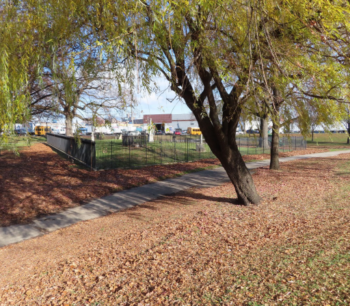
The Joseph Rodman Drake Park and Enslaved People’s Burial Ground. The family cemetery is enclosed by the fence. The enslaved people’s burial ground is adjacent to this tree. Image Credit: NYC LPC.
On December 12, 2023, the Landmarks Preservation Commissioner voted to designate the Joseph Rodman Drake Park and Enslaved People’s Burial Ground as a landmark. The park is located on the block with Oak Point Avenue to the north, Drake Park South to the south, Longfellow Avenue to the west and Hunts Point Avenue to the east. Drake Park was opened in 1910, and contains two colonial-era cemeteries. Prior to European settlement, Hunts Point was home to the Siwanoy people, who were displaced in 1663 when the land was “sold” to English settlers. During the 1700s, three families – the Hunts, the Willetts, and the Leggetts – dominated the area. The Hunt family established a cemetery on the northside of Hunts Point Road for the three families by the 1720s. All three families enslaved both African and Indigenous people, and those enslaved people were buried in a cemetery across Hunts Point Road.
Hunts Point Road was demapped and buried when Drake Park was built around 1910. The park was built to preserve the grave of Hunt family relative and poet Joseph Rodman Drake, who died in 1820. The Hunt-Willets-Leggetts family cemetery is still a feature in Drake Park, with multiple grave markers visible and enclosed by a fence. Some of the notable enslavers buried on the site include Cornelius and Elizabeth Willett, who had enslaved twelve people by 1781, and Thomas Hunt, a Revolutionary War hero, who had enslaved ten people in 1790. According to Landmarks researchers, both Cornelius Willett and Thomas Hunt had listed the people they enslaved to be bequeathed as property in their wills. Willett listed them by first name only, but Hunt did not provide their names at all.
Unlike the family cemetery, the enslaved people’s burial ground did not receive the same amount of care and protection over time. The burials in the enslaved people’s burial ground are anonymous; no visible grave markers remain, and there is no record documenting the names of who is buried there or when they died. The markers that had existed there were present until at least 1920, when published references to the enslaved people’s burial ground stopped appearing. While slavery had been abolished in New York in 1827, the last reported burial in the enslaved people’s burial ground was of Aunt Rose, who had been previously enslaved by the Leggetts family, in the 1840s. She was reportedly buried next to her family and friends who had also been enslaved, but her exact burial site is unknown.
Over time the enslaved people’s burial ground was covered over in dirt, gravel or asphalt. The burial ground was mostly forgotten until 2013, when a New York City Department of Education official found an old photograph of the burial site and began researching. A state grant funded a professional archaeological study that worked with local school children from P.S. 48, the Joseph Rodman Drake School, and helped rediscover the site. The study used a ground-penetrating radar survey that uncovered four likely burials in the portion of the park that was identified as the enslaved people’s burial ground.
The park’s design has changed over time; a renovation in the early 1950’s most likely resulted in the park’s current pathway layout. A park pathway currently runs along what used to be Hunts Point Road, dividing the Hunt-Willett-Leggets family cemetery from the enslaved people’s burial ground once again. The Parks Department officially renamed the “Joseph Rodman Drake Park and Enslaved African Burial Ground” in 2021 with new signage to reflect the site’s history.
The Landmarks Preservation Commission’s current use of “Enslaved People’s Burial Ground” instead of “Enslaved African Burial Ground” aims to include and reflect the documented enslavement of Indigenous people by the Leggett family, who may be included in the burial ground. While a colonial family cemetery and an adjacent enslaved people’s burial ground was a common arrangement, it is highly unusual to find one still existing in a public place within New York City, and it provides an important perspective about the history of enslaved people in New York that often gets overlooked.
Landmarks Commissioner Diana Chapin stated, “I think it’s so important that the, basically what’s been the obliteration of history for a whole group of people for so many years that this is a step at least toward restoring some consciousness of what happened, and maybe, possibly in some cases being able to recover some information about individuals for the future.”
Landmarks Commissioner Everardo Jefferson added, “This is not just a good designation, this is an important one for the Bronx.”
Landmarks Chair Sarah Carroll stated, “This site was on our radar through our archeology department but the site was prioritized as part of LPC’s research survey of the Bronx and it reflects our equity framework and the commitment we made in our equity framework. And as you’ve all said, sites like this are really important because they are important reminders of a painful period in the history of New York when enslaved African and Indigenous peoples helped build the city only to then have their names and final resting places erased from the landscape. This designation would commemorate those people and honor their legacy and protect and preserve this site.”
After the comments from commissioners, the Landmarks Preservation Commission voted unanimously to designate the Joseph Rodman Drake Park and Enslaved People’s Burial Ground.
By: Veronica Rose (Veronica is the Editor of CityLand and a New York Law School graduate, Class of 2018.)

